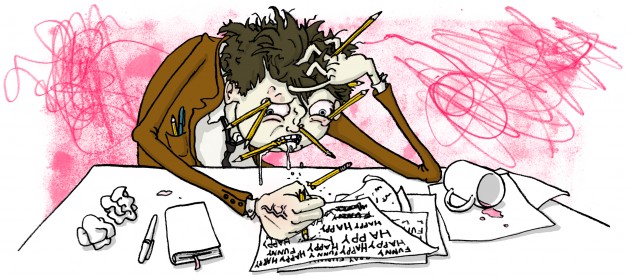Writing for animation (and a new project)
Writing is crucial to animation. There’s a blank world that needs populating by a writer or director and imagination and storytelling need to be employed from the very start of most animated projects. Here’s a look at an adaptation we’re currently working on to give you an idea of the writing process.

The project
We’re about to start working on a side project. It’s an animated comedy short again, but this time we’re working in a completely different way to how we’ve worked before. I won’t go into much detail about the content (because secrets are cool) but this post will hopefully give an insight into how we’re approaching this project from a writing perspective.
The film will be an animated adaptation of something originally written and recorded by Kevin Eldon, the voice of Yorkie in Man in a Cat and all-round comedy leg end. The audio Kevin has already recorded is hilarious, and being fans of both Kevin and laughing, Louis and I got in touch and suggested we turn his work into something new and visual. Luckily, the recording is one of Kevin’s favourites so the project got the green light and we’ll hopefully be making a funny short film from it.
Being an independent adaptation, the project has thrown up some interesting freedoms and limitations. We’re free because there’s no funding, no deadline, no brief, and no sign-off (apart from Kevin’s approval of course). However, we’re limited because there’s no funding, we’re adapting another writer’s work, and the dialogue is already recorded. So on one hand we can do what we want, and on the other we have to find the time and resource to get it made and work to a locked down set of audio recordings. Thankfully, the freedoms are outweighing any limitations at this stage.
Challenges
Despite having the dialogue already written and recorded there are several challenges on the writing front. First we have to cut down over 10 minutes of dialogue into a more palatable length for a short animated film. In doing so we have to keep the jokes and story intact, add a new ending without additional dialogue, and add visual gags and signposting to our new ending. We also have to create a whole visual world and language for the story that will be developed further through design and direction.
The first port of call when writing the adaptation is the original audio. We have no script to work from, so I listened to it many more times than I already had to absorb the characters, story, jokes, and feel of the material. I then transcribed the whole script from the audio, cutting out sections of exposition (descriptions of the setting etc) that could be replaced visually. This reduced the run-time significantly and started to create layers in which visual jokes popped off the dialogue and vice-versa.
The next phase was to cut the audio to match the new draft script. This presented the story in a new form and allowed me to listen for any continuity or pacing issues, but also allowed me to visualise the material from a new perspective and feed that back into the script, adding jokes or story points. This is as far as we’ve got. The next stage is to flesh out the script with visual direction, sight gags and build up the world that will guide the design process. We also need to lock down an ending.
Endings
In my opinion the ending is everything. Without an ending a story is not complete. It has to deliver the message (or messages) of the film whilst tying up all the loose ends and providing a satisfying and logical conclusion to what you’ve just seen. I think it’s telling that of the most successful shorts tend to be the ones with water-tight or surprising endings. We’ve identified what our ending needs to do and have several ideas, but the current task is to condense those themes into the most efficient and effective scene we can, being mindful of runtime and continuity.
As a side note, Kevin’s original recording doesn’t have a bad ending. It’s just that we’ve identified an opportunity to add a whole new satisfying conclusion that stays true to the spirt of the rest of the material. And it can be done without dialogue. Win. Handily, Kevin wants to be involved in the process, so we’ll be sending over script drafts to him for for his unique input into the visual side of the project.
The next steps
So once the edited dialogue, sight gags, and story is locked down the director/designer will take over. The writing process for animation is so important. ‘Reshoots’ (or re-draws perhaps) are expensive, time-consuming, and can throw continuity and pacing completely out of the window.
We’ll try to follow this post up with more production notes but we really don’t know how long the process will take. If you’d like to fund this endeavor or help out, then please do get in touch.

